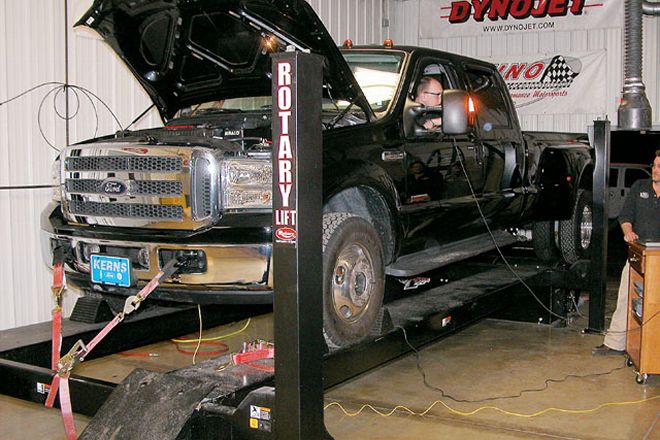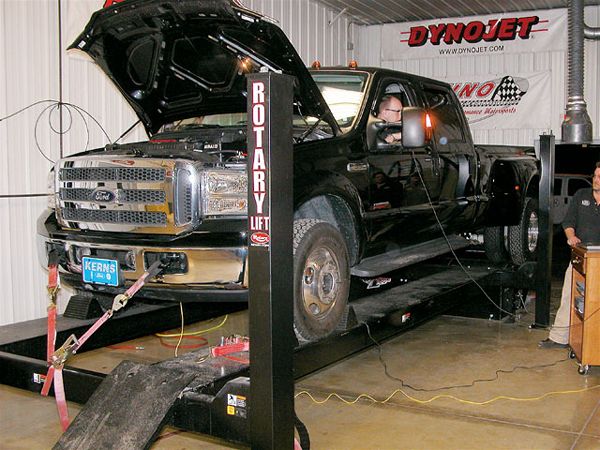
When it debuted a couple of years ago, the new 6.0L Power Stroke amazed everyone by making more power from fewer cubic inches of displacement. Still, no matter how well the engine performs, there are always those out there who want more, and that's what this story is all about.

Most owners follow a well-marked road to increasing power on their modern electronically controlled diesels: Namely, exhaust, intake, and chip. Some go way beyond that, of course, but we thought you'd like to see the results from a few well known and respected products on a spankin' new '05 F-350 Crew Cab Dualie with only 800 miles. We utilized the test facilities of the University of Northwestern Ohio and Instructor Scott Martin's Alternative Fuels II class to both do the dyno tests and to install the products.
Martin's class had a chance to do a quick dyno test before the truck went off to get a Magnaflow exhaust system installed, but we weren't there to see it. We did get to shoot the class installing an Airaid intake system, Edge Juice Module and Attitude Monitor, and an ATS TorquePro 2000 propane-injection system.
The benefits of a big-bore, mandrel-bent exhaust are well documented. Magnaflow's 4-inch stainless system incorporates all of the best technology to maximize exhaust flow. Along the same lines, the Airaid cool-air high-flow intake system increases intake breathing in a major way. "Why then," you ask, "did you only pick up only 8 hp by installing both?" Good question.
When a free-flow intake and exhaust really become necessary is when the engine's power output increases due to increased fueling, boost, and timing from a chip or a fuel-injection programmer. To make that extra power, you need more airflow in and out. Changes in programming alone may quickly overcome the stock truck's inability to breathe. This will then limit the potential output from the chip or tuner and usually cause EGTs to rise to terminal levels more quickly in any situation.
First, this was a new truck, and that was bound to hold back gains to some degree. Second, how much you gain from either improvement (or both) is directly proportional to how well or poorly the original systems flow according to the engine's true needs. That means the results on an otherwise stock engine can run from so-so to significant. Remember that power and torque are all about a mixture of air and fuel. The new intake and exhaust let the engine develop a few more ponies from the stock programming, and that's a good thing. Without more fuel being introduced, more boost, and changes in injection timing, that was the end of the gains.
Among the hidden benefits of high-flow intake and exhaust systems are lower exhaust gas temperatures (EGTs). This is especially important to a towing truck grinding up that long grade with a heavy load. Every degree of cooler air going in results in EGTs cooler by that same amount. A free-flow exhaust also offers cooler EGTs, and the bottom-line benefit is that you can safely run your truck just that much harder with both of those mods, even if the power output is only mildly enhanced.
Propane injection is a story in itself. Propane injected into the incoming air both oxidizes and provides extra fuel to the incoming air charge. The result is the same as adding fuel and air at the same time, and the results can be dramatic. Combined with other mods, it can provide true "Yee hah" diesel performance, as evidenced by our 6.0L's 423hp rear-wheel dyno run. With automatic transmissions struggling to keep up with today's performance diesel mods, you'll want to take care when you reach those sorts of levels. Fortunately, the aftermarket is working to keep up by offering the appropriate auto tranny mods, so most times there's no excuse for smoking a tranny. If your wallet's too thin to spring for the appropriate tranny mods, self-control is needed in going for those big-power mods.
So, how did the big Ford do after the mods were complete? Without propane, we recorded just over a 100hp gain. With propane, we got close to 150 hp. Unfortunately, we missed the opportunity to do some 0-60mph tests on the bone-stock truck, but by averaging available test information for similar trucks, we think a very respectable 10.5 seconds would be a good number. After the mods, our tests yielded an average of 8.4-second 0-60 times-without propane injection. That's a very respectable number for a truck that weighs in at over 7,500 pounds.
Danger, Will Robinson!
As this story was being produced, we ran into some information that 6.0L owners might want to heed. We've been hearing reports of head-gasket failures on 6.0Ls that are being worked hard. The "chickens" in that "chick-'n'-egg" scenario appear to be the head bolts, which fail by stretching and allow the head gasket to leak or blow. The same thing is happening to modified 6.0L Power Strokes that are being run hard.
Some will say the change from six head bolts on the old 7.3L Power Strokes to four bolts per cylinder on the 6.0L is the major problem. According to some of the experts we consulted, that's sorta true and sorta not. Yes, there are only four bolts on the 6.0L, but they are very much beefier than the 7.3L's. The gasket is much better on the 6.0, and it was improved for '05. The main problem is that the bolts stretch under high combustion pressures and allow some gas to escape. At first, that happens only under high-pressure conditions, but eventually the gasket degrades and begins to leak all the time. The answers to this problem are studs that do not stretch. There are some high-performance bolts on the market now from Diesel Performance Specialties (DPS) and Automotive Racing Products (ARP), with BD Performance and ATS likely offering kits by the time you read this.
The big question for 6.0L owners is, at what point should studs be factored in with other mods? We spoke to Ken Englesman, the Ford expert at DPS. They have been dealing with these problems from the outset and have had a chromoly stud kit since 2004. Englesman's answer was that any mods producing more than 100 to 130 hp over stock should have a stud kit installed. Definitely mods that include injectables like propane, nitrous, or water should have the stud kits because these all drastically increase cylinder pressure.
Removing the old bolts and installing the stud kit is not a piece of cake. You can pull the bolts and install the studs singly, but the rear bolts are difficult and usually require you to unbolt and lift the cab 5 inches or so for clearance. Englesman's advice is to pull the engine to do the job, pull the heads, and install the improved Ford gaskets at the same time.
Rear-Wheel Horsepower and Torque DynoJet 224 Chassis Dyno* Dyno Test Results: ’05 {{{Ford F-350}}} Super Duty 6.0L, SR100 five-speed automatic Condition Power Torque Stock, with 800 miles 275.6 hp 469.6 lb-ft With Airaid & Magnaflow 283.9 hp 477.2 lb-ft With Airaid, Magnaflow & TorquePro 359.4 hp 675.8 lb-ft With Airaid, Magnaflow & {{{Edge}}} L1 313.6 hp 577.4 lb-ft With Airaid, Magnaflow, Edge L1 & TorquePro 369.6 hp 689.5 lb-ft With Airaid, Magnaflow & Edge L2 320.9 hp 612.5 lb-ft With Airaid, Magnaflow, Edge L2 & TorquePro 373.9 hp 692.6 lb-ft With Airaid, Magnaflow & Edge L3 338.6 hp 658.0 lb-ft With Airaid, Magnaflow, Edge L3 & TorquePro 385.5 hp 719.3 lb-ft With Airaid, Magnaflow & Edge L4 349.0 hp 704.4 lb-ft With Airaid, Magnaflow, Edge L4 & TorquePro 389.9 hp {{{740}}}.0 lb-ft With Airaid, Magnaflow & Edge L5 376.7 hp 784.7 lb-ft With Airaid, Magnaflow, Edge L5 & TorquePro 423.6 hp 838.8 lb-ft *DynoJet located at University of Northwestern Ohio








